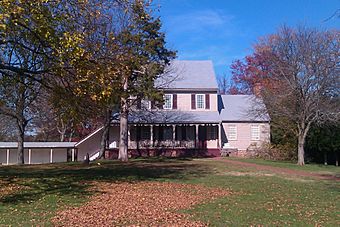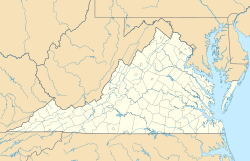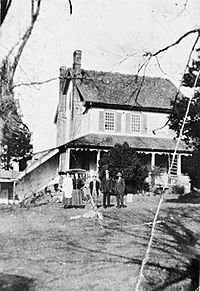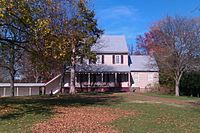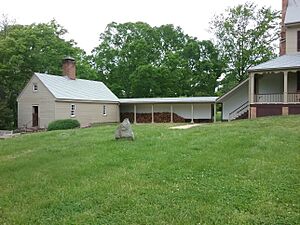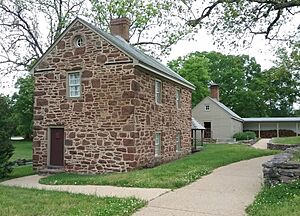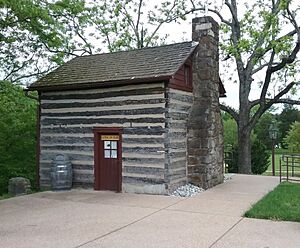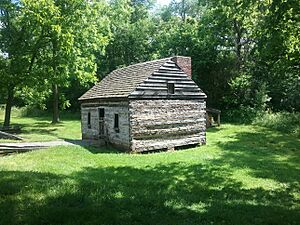Sully Historic Site facts for kids
Sully Historic Site is a special place in Chantilly, Virginia. It is recognized as both a Virginia landmark and a national historic place. This means it is an important part of history for both Virginia and the entire country.
The land where Sully stands was first claimed by the Doeg people, a Native American tribe. Later, the Lee family of Virginia owned the land for many years, from 1725 to 1839. Richard Bland Lee built the main house in 1794. After the Lee family, several other private owners lived at Sully. They used it as a home, a working farm, or both. In 1958, the United States government bought Sully. This was part of the plan to build Dulles Airport nearby. Today, the Fairfax County Park Authority takes care of Sully. They focus on teaching visitors about the Lee family's time there.
Sully's Story Through Time
Early Days of the Land
Before the Lee family, the land that became Sully was likely used by different groups. English settlers came to Northern Virginia and met the Algonquian-speaking Doeg tribe. There were conflicts between the English colonists and the Doeg people from 1661 to 1664. After some fighting, the English gained control of the area around 1666. Not much is known about the land until the Lee family officially received it.
The Lee Family Era
The Lee family's connection to Sully began in 1725. Henry Lee I, Richard Bland Lee's grandfather, first acquired the land. His son, Henry Lee II, inherited it. When Henry Lee II passed away in 1787, the land was split between his sons, Richard and Theodorick Lee. Richard, being the older brother, received the northern part of the land. He had already been managing the property since about 1781. During this time, the main crop grown on the farm was tobacco.
Richard Bland Lee's Farm Changes
Richard Bland Lee made big changes to the farm. He grew much less tobacco. Instead, he focused on crops that were better for the soil, like wheat, corn, rye, and barley. This helped keep the soil healthy and allowed him to use crop rotation. He also planted fruit orchards with peach and apple trees. He even used the fruit to make spirits. In 1801, Richard built a dairy building. His wife, Elizabeth Collins Lee, mostly managed the dairy.
Richard was elected to the United States Congress in 1789. For the next five years, his brother Theodorick helped manage the farm. Theodorick oversaw the planting and harvesting. He also collected rent from the tenant farmers who worked on the land. Construction on the large main house, which Richard had planned, started in 1794. Richard had chosen the name "Sully" for his estate before he left for Congress.
By 1811, Richard Bland Lee had a lot of debt. He had tried to help his brothers, Henry Lee III and Charles Lee, with their own money problems. Because of this, Richard decided he could no longer keep Sully. He sold the plantation for $18,000 to his second cousin, Francis Lightfoot Lee II.
Francis Lightfoot Lee II's Time at Sully
For several years after buying Sully, Francis Lightfoot Lee II, known as F. L. to his family, made a good profit from the farm. Part of his success was thanks to his wife, Jane Fitzgerald Lee, who was very good at managing the farm. Sadly, Jane Fitzgerald Lee passed away in 1816 after giving birth to their fifth child. Four years later, in 1820, F. L. became very unwell. He was later moved to a hospital in Philadelphia in 1825.
After F. L. became unwell, Sully was managed by his nephew, Richard Henry Lee II. However, Richard Henry Lee II did not manage the estate well. Money was lost, and the farm was not cared for properly. Other people were then put in charge, but they also struggled to manage Sully as well as F. L. had.
Most of F. L.'s children left Sully as they grew up. His daughter, Jane Elizabeth Lee, married Henry Tazewell Harrison at Sully in 1834. Harrison then took over managing the estate. Finally, in 1838, Sully was sold to a merchant named William Swartwort.
Sully After the Lee Family
From 1838 onwards, Sully was owned by many different people. It continued to be used as a home, a working farm, or both. In 1958, the federal government bought the property to build Dulles Airport. People immediately started a campaign to save Sully. Former owners, descendants of the Lee family, and a neighbor named Eddie Wagstaff all helped. This effort worked! In 1959, President Dwight D. Eisenhower signed a law that made Sully a national historic site.
The Fairfax County Park Authority agreed to run Sully as a county historical park. They have since added more land, bringing the total size of Sully Historic Site to about 120 acres (490,000 m2; 5,200,000 sq ft; 49 ha). The park focuses on the time when Richard Bland Lee and Francis Lightfoot Lee owned Sully (1787–1838). The site is furnished with items from the Federal period to show what it looked like when the Lee family lived there.
Who Owned Sully?
- 1725–1747 Henry Lee I
- 1747–1787 Henry Lee II
- 1787–1811 Richard Bland Lee
- 1811–1839 Francis Lightfoot Lee II (purchased from his second cousin)
- 1838–1841 William Swartwort
- 1842–1842 Jacob and Amy Haight
- 1842–1852 Alexander Haight
- 1852–1869 James and Marie Haight Barlow
- 1869–1874 Stephen Shear
- 1874–1910 Conrad Shear
- 1910–1919 William Eads Miller, real estate agent
- 1919–1939 King and Rebecca Poston (converted Sully to a dairy farm)
- 1939–1946 Walter Thurston, United States ambassador to Mexico
- 1946–1958 Frederick E. Nolting, Jr., United States ambassador to South Vietnam
- 1958–1959 Federal Aviation Administration
- 1959–present Fairfax County Park Authority
Historic Drawings of Sully
These drawings from 1960 are part of the Historic American Buildings Survey. They show details of Sully's main house.
Other Buildings at Sully
The Kitchen and Laundry Building
This building is split into two parts by a large fireplace. One side was the kitchen, and the other was the laundry room. Both shared the same chimney. This kitchen building was built at the same time as the main house.
Here are more drawings from the 1960 Historic American Buildings Survey showing the Kitchen.
The Stone Dairy
Richard Bland Lee built this stone dairy around 1801-1802. Its thick stone walls helped keep milk cool. This building is special because of its "galleted" or "garneted" masonry. This means small stones are pressed into the mortar joints, which is unusual to see in North America.
Here are drawings from the 1960 Historic American Buildings Survey of the Dairy, sometimes called a "Patent House".
The Schoolhouse
This log schoolhouse was originally from Antioch Farm in Haymarket, Virginia. It was moved to Sully Historic Site in 1963 to be preserved.
The Slave Cabin
This building is a copy of a cabin where enslaved workers lived. It was built in 2001. Its location and how it was built are based on old records and information found by archaeologists.


